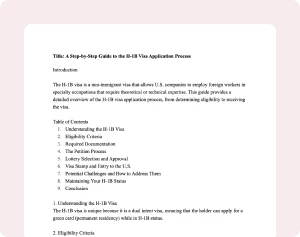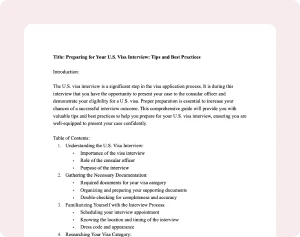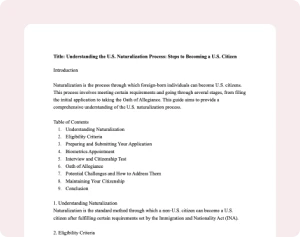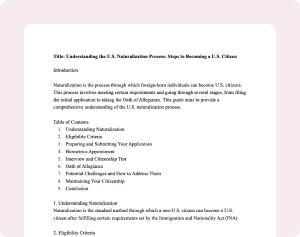Access our library of downloadable resources to help you better understand immigration processes and requirements. Our guides cover topics such as visa application procedures, documentation requirements, and interview preparation.

This comprehensive guide provides a detailed overview of the H-1B visa application process, including eligibility criteria, required documentation, filing procedures, and potential challenges. Learn how to navigate each step of the application process and improve your chances of obtaining an H-1B visa

The visa interview is a crucial part of the U.S. visa application process. This guide offers valuable tips and best practices for preparing for your interview, including gathering the necessary documentation, understanding the role of the consular officer, and practicing common interview questions.

This guide provides a detailed overview of the family-based immigration process in the United States, including eligibility criteria, required documentation, filing procedures, and potential challenges. Learn how to navigate each step of the process and improve your chances of obtaining a family-based visa or green card.

Becoming a U.S. citizen through naturalization is a significant milestone for many immigrants. This guide offers a comprehensive overview of the naturalization process, including eligibility requirements, application procedures, and the citizenship test. Learn how to successfully navigate the path to U.S. citizenship.
Find answers to frequently asked questions about various immigration topics. Our FAQs cover a wide range of subjects, including visa types, application procedures, and eligibility requirements.
The H-1B visa is for foreign workers in specialty occupations who have a bachelor’s degree or higher, while the L-1 visa is for intracompany transferees, allowing employees of multinational companies to transfer to a U.S. branch, affiliate, or subsidiary. Both visas have different eligibility criteria and application processes.
Yes, it is possible to apply for a green card while on a temporary work visa, such as an H-1B or L-1 visa. The process typically involves an employer sponsoring the employee for an employment-based green card, which requires meeting specific eligibility criteria and completing several steps, including labor certification and filing an immigrant petition.
Processing times for U.S. visa applications vary depending on the visa type, the applicant’s country of residence, and the specific U.S. embassy or consulate handling the application. In general, non-immigrant visa processing times can range from a few weeks to several months, while immigrant visas may take several months to over a year.
In some cases, applicants with a pending green card application may be eligible to apply for an Employment Authorization Document (EAD) that allows them to work legally in the United States while awaiting a decision on their application.
A green card grants a foreign national permanent residence in the United States, allowing them to live and work in the country indefinitely. U.S. citizenship, on the other hand, is obtained through the naturalization process and provides additional rights and benefits, such as voting in federal elections and holding a U.S. passport.
If you have a pending green card application and need to travel outside the United States, you may be eligible to apply for Advance Parole, a travel document that allows you to leave and re-enter the country without abandoning your application. It is important to obtain Advance Parole before departing the United States to avoid complications with your green card application.
Explore our glossary of common terms and concepts in immigration law. This comprehensive resource is designed to help you better understand the language and terminology used in immigration processes.
Adjustment of Status: The process of applying for permanent residence (green card) while already present in the United States.
Consular Processing: The process of applying for an immigrant visa at a U.S. embassy or consulate abroad.
Employment Authorization Document (EAD): A document issued by USCIS that grants certain non-citizens the right to work legally in the United States.
Priority Date: The date on which an immigrant petition or labor certification application is filed, which determines an applicant's place in line for a visa number.
Affidavit of Support: A legal document in which a U.S. citizen or permanent resident agrees to financially support a foreign national applying for an immigrant visa or adjustment of status.
Labor Certification: A process in which the U.S. Department of Labor (DOL) certifies that there are no qualified U.S. workers available for a specific job and that employing a foreign worker will not adversely affect the wages and working conditions of similarly employed U.S. workers.
Public Charge: A term used by U.S. immigration authorities to describe a person who is likely to become primarily dependent on the government for subsistence, which may affect their eligibility for a visa or green card.
1717 N Street Nw - Ste 1 Washington, DC, 20036
Tel +1 (407) 490-3132
6735 Conroy Rd, 3 Andar, Suite 306, Orlando, FL 32835 United States
324 Wyss Street, Johnstown, CO 80534
Tel +1 (407) 490-3132
Rua Estela 515, Bloco A, 1 andar, Paraíso - CEP 04011-002
Tel (11) 5087-4810
SRTVS, Q. 701 - Lote 4 - Bloco O - Sl. 203 - Centro Multiempresarial CEP 70340-000 - Brasília / DF
Tel (61) 3967-3431
Rua Torquato Bahia, n° 04 - Sl. 509 - Comércio - CEP 40015-110 Salvador / BA
(71) 3242 0769
© 2025 Steiner, Kleim & White. All rights reserved.
Please note that the information provided is for general informational purposes only and should not be considered legal advice. Each case is unique, and we strongly encourage you to consult with one of our team member to discuss your specific situation.
O visto EB-2 NIW (National Interest Waiver) pode ser concedido a profissionais qualificados, incluindo aqueles com bacharelado + 5 anos de experiencia profissional, mestrado, pós-graduação, experiência excepcional ou empreendedores cujas atividades possam beneficiar os Estados Unidos. A seguir, listamos algumas das principais áreas e profissões que frequentemente se qualificam para esse visto:
✔ Engenheiro de Software
✔ Engenheiro de Inteligência Artificial
✔ Engenheiro de Dados / Cientista de Dados
✔ Engenheiro Mecânico
✔ Engenheiro Civil
✔ Engenheiro Elétrico / Eletrônico
✔ Engenheiro de Automação
✔ Engenheiro Biomédico
✔ Engenheiro de Energia Renovável
✔ Engenheiro Aeroespacial
✔ Engenheiro Químico
✔ Engenheiro de Telecomunicações
✔ Engenheiro de Segurança Cibernética
✔ Desenvolvedor de Software / Full Stack
✔ Médico: especialidades como cardiologia, neurologia, oncologia
✔ Cientista Biomédico
✔ Pesquisador em Biotecnologia
✔ Farmacêutico com pesquisas inovadoras
✔ Epidemiologista
✔ Geneticista
✔ Químico com experiência em desenvolvimento de novos materiais
✔ Especialista em Saúde Pública
✔ Especialista em Nanotecnologia Aplicada à Saúde
✔ Fundador de Startup com inovação tecnológica
✔ Empresário com experiência em expansão de negócios
✔ Especialista em Comércio Exterior
✔ Consultor em Sustentabilidade e Impacto Ambiental
✔ Especialista em Desenvolvimento Econômico
✔ CEO / Executivo Sênior com impacto reconhecido no setor
✔ Especialista em Inteligência de Mercado
✔ Especialista em Finanças e Investimentos Estratégicos
✔ Especialista em Logística e Cadeia de Suprimentos
✔ Especialista em Educação e Treinamento Corporativo
✔ Especialista em Energias Renováveis (solar, eólica, biomassa)
✔ Especialista em Sustentabilidade Ambiental
✔ Engenheiro Ambiental
✔ Especialista em Conservação de Recursos Naturais
✔ Pesquisador em Mudanças Climáticas
✔ Especialista em Tecnologia para Redução de Emissões de Carbono
✔ Jornalista Investigativo
✔ Escritor/Publicitário com impacto reconhecido
✔ Produtor Audiovisual com contribuições significativas
✔ Designer Gráfico e UX/UI Designer
✔ Fotógrafo Premiado
✔ Músico com carreira reconhecida
✔ Diretor de Cinema ou Teatro com impacto cultural
✔ Especialista em Educação e Cultura
✔ Professor Universitário com pesquisas inovadoras
✔ Pesquisador em Políticas Públicas
✔ Especialista em Inteligência Artificial Aplicada à Educação
✔ Cientista Social com impacto comprovado em estudos de desenvolvimento
✔ Advogado especializado em Direitos Humanos e Impacto Social
✔ Especialista em Políticas Públicas e Desenvolvimento Sustentável
✔ Consultor Jurídico Internacional
✔ Especialista em Compliance e Regulação
✔ Especialista em Cibersegurança
✔ Cientista de Dados e Machine Learning
✔ Especialista em Blockchain e Criptografia
✔ Engenheiro de Redes e Infraestrutura
✔ Desenvolvedor de Inteligência Artificial
✔ Especialista em Automação de Processos
Empreendedores que demonstram inovação tecnológica, impacto econômico e crescimento escalável nos EUA têm grandes chances no EB-2 NIW. Exemplos incluem:
✔ Startups de Tecnologia com produtos disruptivos
✔ Empresas de Software com inovação reconhecida
✔ Negócios na área de Educação Digital e EAD
✔ Empresas de Sustentabilidade e Energia Renovável
✔ Empreendedores no setor de Biotecnologia
Lembre-se: o EB-2 NIW não é baseado em uma lista fixa de profissões, mas sim no impacto que o profissional pode gerar nos EUA. Se você é altamente qualificado em sua área e seu trabalho pode beneficiar o país, vale a pena explorar essa opção!